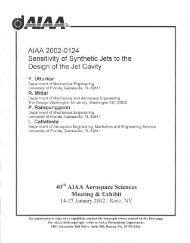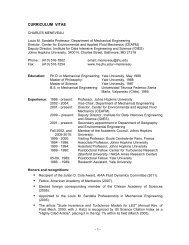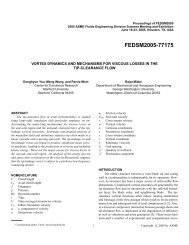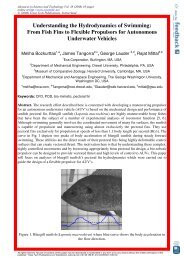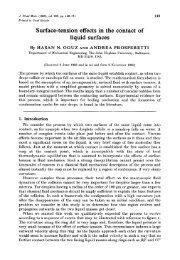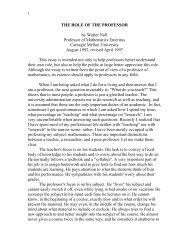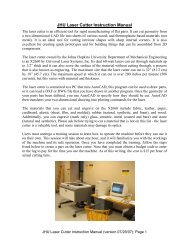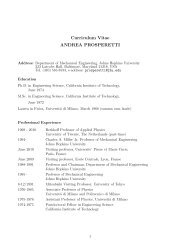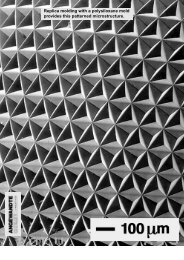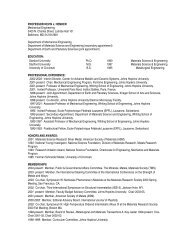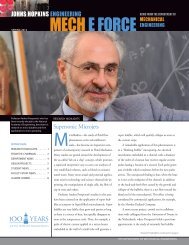A Sharp Interface Cartesian Grid Method for Simulating Flows with ...
A Sharp Interface Cartesian Grid Method for Simulating Flows with ...
A Sharp Interface Cartesian Grid Method for Simulating Flows with ...
You also want an ePaper? Increase the reach of your titles
YUMPU automatically turns print PDFs into web optimized ePapers that Google loves.
350 UDAYKUMAR ET AL.<br />
and surface of the control volume and ˆn is a unit vector normal to the surface of the control<br />
volume. The above equations are to be solved <strong>with</strong> ⃗u(⃗x, t) =⃗u ∂ (⃗x,t)on the boundary of<br />
the flow domain where ⃗u ∂ (⃗x, t) is the prescribed boundary velocity, including that at the<br />
moving immersed boundary. The above equations <strong>with</strong> the moving immersed boundary are<br />
to be discretized and solved on a <strong>Cartesian</strong> mesh shown in Fig. 1. The discretization of<br />
the above equations in the context of a stationary immersed boundary is described first.<br />
With this as the basis, the discretization scheme in the presence of moving boundaries is<br />
described subsequently.<br />
2.2. Flow Solver <strong>with</strong> Stationary Immersed Boundaries<br />
As the first step, the curved immersed boundary is represented using marker particles<br />
which are connected by piecewise quadratic curves parameterized <strong>with</strong> respect to the arclength<br />
s. Details regarding interface representation, evaluation of derivatives along the<br />
interface to obtain normals, curvatures, and so <strong>for</strong>th, have been presented in previous papers<br />
[48, 58] and are not repeated here. Also described in earlier papers are details regarding<br />
the projection of the immersed boundary onto the underlying fixed <strong>Cartesian</strong> mesh. This<br />
includes determining the intersection of the boundary <strong>with</strong> the mesh; identifying the phase<br />
(solid or fluid) of each cell; and determining procedures <strong>for</strong> obtaining a mosaic of control<br />
volumes, which are clearly demarcated by the immersed boundary. This results in the <strong>for</strong>mation<br />
of control volumes adjacent to the immersed boundary that are trapezoidal in shape, as<br />
shown in Fig. 1. Depending on the location and local orientation of the immersed boundary,<br />
trapezoidal cells of varying aspect ratio are <strong>for</strong>med. It should be pointed out that due to the<br />
cell-merging operation [58], the nominal aspect ratio of the trapezoidal cells is limited to a<br />
range between 0.5 and 1.5, which is advantageous from the point of view of conditioning of<br />
the discrete operators. With the boundary-adjacent grid cells reconstructed in this manner,<br />
we now turn to the discretization of the governing Eqs. (1) and (2) on this grid.<br />
A two-step, mixed explicit–implicit fractional step scheme [31] is used <strong>for</strong> advancing the<br />
solution of the above equations in time. The Navier–Stokes equations are discretized using<br />
a cell-centered, colocated (nonstaggered) arrangement [39, 59] of the primitive variables<br />
(⃗u, p). In addition to the cell-center velocities, which are denoted by ⃗u, face-center velocities<br />
⃗Uare also computed. In a manner similar to a fully staggered arrangement, only the<br />
component normal to the cell-face is computed and stored (see Fig. 1b). The face-center<br />
velocity is used <strong>for</strong> computing the volume flux from each cell in the current finite-volume<br />
discretization scheme. The advantage of separately computing the face-center velocities has<br />
been discussed in the context of the current method in [58]. The solution is advanced from<br />
time level t to t + t through an intermediate advection–diffusion step where the momentum<br />
equations <strong>with</strong>out the pressure gradient terms are first advanced in time. A second-order<br />
Adams–Bash<strong>for</strong>th scheme is employed <strong>for</strong> the convective terms, and the diffusion terms are<br />
discretized using an implicit Crank–Nicolson scheme. This eliminates the viscous stability<br />
constraint, which can be quite severe in simulation of viscous flows. The discretized <strong>for</strong>m<br />
of the advection–diffusion equation <strong>for</strong> each cell shown in Fig. 1 can there<strong>for</strong>e be written as<br />
St ⃗u∗ −⃗u t<br />
V=− 1 ∑<br />
[3 ⃗u t ( ⃗U t · ˆn f ) −⃗u t−t (⃗U t−t·ˆn f )]S f<br />
t<br />
2<br />
f<br />
+ 1<br />
2Re<br />
∑<br />
[∇u ∗ +∇u t ]· ˆn f S f , (3)<br />
f



